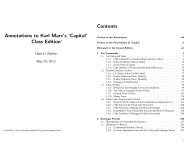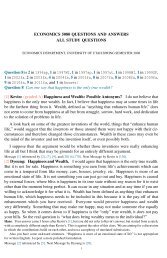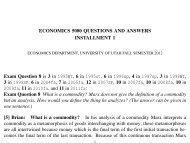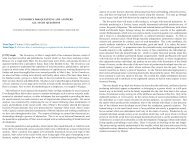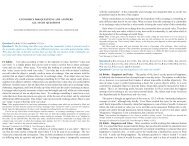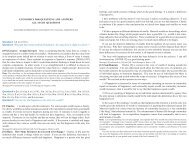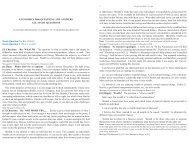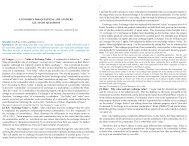Question 1 What did Marx mean with his formu - University of Utah
Question 1 What did Marx mean with his formu - University of Utah
Question 1 What did Marx mean with his formu - University of Utah
You also want an ePaper? Increase the reach of your titles
YUMPU automatically turns print PDFs into web optimized ePapers that Google loves.
U <strong>of</strong> <strong>Utah</strong> Econ 5080 2005fa 99<br />
machine and the labor and skill used to create t<strong>his</strong> commodity. In the case <strong>of</strong> the coat the<br />
sewing machine becomes capital but still carries to the coat a portion <strong>of</strong> the labor value from<br />
the production <strong>of</strong> the machine. I think t<strong>his</strong> aspect <strong>of</strong> value is the one that <strong>Marx</strong> sees as being<br />
exploited the most or in allowing the labor to be exploited by removing a little more <strong>of</strong> the<br />
“organic” value <strong>of</strong> the commodity <strong>with</strong> each cycle <strong>of</strong> development.<br />
Hans: In <strong>Marx</strong>’s theory, all value comes from labor, i.e., all value is what you call “organic”. Your theory <strong>of</strong><br />
exploitation has nothing to do <strong>with</strong> <strong>Marx</strong>.<br />
Next Message by Danske is [1925].<br />
<strong>Question</strong> 164 is 170 in 2004fa, 186 in 2007fa, and 203 in 2009fa:<br />
<strong>Question</strong> 164 The relationship “20 yards <strong>of</strong> linen are worth 1 coat” says that 20 yards <strong>of</strong><br />
linen have the same value as 1 coat, but it says nothing about the value <strong>of</strong> the coat itself.<br />
Right or wrong?<br />
[242] Ace: graded B+ It takes careful (As Submitted:) It takes careful reading<br />
reading <strong>of</strong> the text to understand t<strong>his</strong>, so I <strong>of</strong> the text to understand t<strong>his</strong>, so I hope t<strong>his</strong><br />
hope t<strong>his</strong> is right. The “20 yards <strong>of</strong> linen is right. The “20 yards <strong>of</strong> linen are worth<br />
are worth one coat” says nothing about the one coat” says nothing about the value <strong>of</strong><br />
value <strong>of</strong> the coat, so the second half <strong>of</strong> the coat, so the statement is right. T<strong>his</strong> is<br />
the statement is right. But the first half why, the text says “the linen weaver does<br />
<strong>of</strong> the statement contradicts the text, which not compare the value <strong>of</strong> the linen <strong>with</strong> the<br />
value <strong>of</strong> the coat” (Ehrbar 97). <strong>What</strong> is try-<br />
says “the linen weaver does not compare the ing to be said is that the weaver knows the<br />
value <strong>of</strong> the linen <strong>with</strong> the value <strong>of</strong> the coat” amount <strong>of</strong> labor and effort that went into<br />
(Ehrbar 97). The weaver knows the amount making the 20 yards <strong>of</strong> linen, basically the<br />
<strong>of</strong> labor and effort that went into making weaver knows the use value <strong>of</strong> the linen.<br />
the 20 yards <strong>of</strong> linen, basically the weaver The weaver then has to decide if one coat<br />
knows the value <strong>of</strong> the linen. The weaver is worth the use-value <strong>of</strong> the linen. It is a<br />
then has to decide if the use-value <strong>of</strong> hav- decision that has to be made by the weaver<br />
ing one coat is worth the value <strong>of</strong> the linen.<br />
I.e., he does not compare the value <strong>of</strong> the<br />
coat <strong>with</strong> the value <strong>of</strong> the linen, but he compares<br />
the use-value <strong>of</strong> the coat <strong>with</strong> the value<br />
<strong>of</strong> the linen. In <strong>Marx</strong>’s words, he expresses<br />
the value <strong>of</strong> the linen in the use-value <strong>of</strong> the<br />
coat.<br />
and no one else.<br />
Hans: Much <strong>of</strong> what you say is right, but on other places there are oversights or confusions. I edited your text to<br />
fix those errors. The edited text is shown in the left column, your original in the right column.<br />
Message [242] referenced by [312]. Next Message by Ace is [795].<br />
[244] Snickers: graded A– That is a correct assumption to say that the value <strong>of</strong> the coat is<br />
not expressed by the 20 yards <strong>of</strong> linen. It is only stating that 20 yards <strong>of</strong> linen are worth that<br />
<strong>of</strong> one coat, not the other way around. If technology increased in the linen manufacturing<br />
then more linen would be produced, thus the exchange rate for linen could increase to 30<br />
yards <strong>of</strong> linen for one coat. That does not say that the value <strong>of</strong> the coat has increased but<br />
just the “exchange proportion is an expression <strong>of</strong> the value <strong>of</strong> linen” Hans stated, not an<br />
100 2005fa Econ 5080 U <strong>of</strong> <strong>Utah</strong><br />
expression <strong>of</strong> the value <strong>of</strong> the coat. The price <strong>of</strong> the coat has not changed just the value <strong>of</strong><br />
linen. Now, if the coats require more labor the price for coats will rise but t<strong>his</strong> has no effect<br />
on the linen producer since the time needed to make the linen does not change. T<strong>his</strong> shows<br />
that the relationship between the value <strong>of</strong> 20 yards <strong>of</strong> linen being worth one coat, does not<br />
represent the value <strong>of</strong> the coat. Now <strong>with</strong> the increased coat price coat makers will be not<br />
wanting to give coats away for 20 yards <strong>of</strong> linen. So linen manufactures now will have to pay<br />
more linen per coat, they have not changed the value <strong>of</strong> the coat, just the coat makers setting<br />
a new price for the coats and the market forces the linen manufactures to adjust acordingly.<br />
As Hans states, “The exchange proportion the linen weaver agrees to depends on the value<br />
<strong>of</strong> coats, but the linen weaver’s agreement is not an expression <strong>of</strong> the value <strong>of</strong> coats.” So just<br />
because 20 yards <strong>of</strong> linen is equal to one coat that can not be used to determine what the<br />
value <strong>of</strong> the coat is.<br />
Hans: Your second sentence should read: “It is only expressing the value <strong>of</strong> the 20 yards <strong>of</strong> linen in the use-value<br />
<strong>of</strong> the coat, but not comparing it <strong>with</strong> the value <strong>of</strong> the coat.” Other than that, your answer is ok.<br />
Message [244] referenced by [312]. Next Message by Snickers is [696].<br />
<strong>Question</strong> 170 <strong>What</strong> are the limits <strong>of</strong> the analogy <strong>with</strong> the sugar loaf? (Describe t<strong>his</strong> analogy)<br />
[283] Mjk: The most analogy <strong>of</strong> the sugar loaf is that “first” is mass, or heavyness that<br />
would be invisible property <strong>of</strong> the thing which may expresses itself in the force pulling t<strong>his</strong><br />
thing toward the earth. For instance, if one has a piece <strong>of</strong> iron on one’s hands, you can not<br />
see or smell or otherwise touch and tell how much mass it contains any better than sugar<br />
loaf.<br />
Another thing we should consider the most is that if the need arises to express the heavyness<br />
<strong>of</strong> the matter <strong>of</strong> the sugar-loaf, i.e for example, because the individual wants to buy the<br />
sugar or may use it in different way or in a recipe and therefore needs to know exactly how<br />
much sugar it contains when places on the scale to be weighted and at the same time look<br />
how much should the iron weights. As a result, I think iron itself is no better incarnation <strong>of</strong><br />
heavy matter than the sugar-loaf.<br />
By the way, to express the sugarloaf as a heavy matter, we can compare theme to place it<br />
into a weight relation <strong>with</strong> the iron to find out the heavyness <strong>of</strong> each item.<br />
In t<strong>his</strong> case, iron is found as a body that represents nothing but heavy matter. Therefore,<br />
an iron is to be compared to measure the weight <strong>of</strong> sugar; in relationship <strong>with</strong> sugar, heavy<br />
matter pure, and simple, and the incarnation <strong>of</strong> the heavy matter.<br />
Hans: Much <strong>of</strong> your answer is a copy or paraphrase <strong>of</strong> text on pp. 101-102 <strong>of</strong> the Annotations, originally <strong>with</strong><br />
sometimes sense-distorting typos. And nothing about the limits <strong>of</strong> the analogy. Please use your own words in future<br />
submissions, so that I can tell how much you understand.<br />
Next Message by Mjk is [481].<br />
<strong>Question</strong> 176 is 196 in 2007SP:<br />
<strong>Question</strong> 176 Aristotle wrote: ‘There can be no exchange <strong>with</strong>out equality, and no equality<br />
<strong>with</strong>out commensurability.’ <strong>What</strong> does he <strong>mean</strong> by t<strong>his</strong>? <strong>What</strong> is the difference betwee<br />
equality and commensurability?



